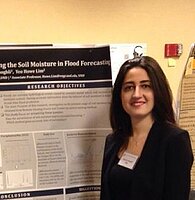Design Parameters of Embankment Dams in the Upper Midwest in Potential Climate Change Conditions

Bahareh Shoghli is a PhD student in civil engineering Program at University of North Dakota. She holds a master of science in Hydraulic Structures from University of Tehran, and Bachelor of Civil Engineering from Khajeh Nasir Toosi University of Technology, IRAN. Her present research is focused on understanding design parameters of embankment dams in the Upper Midwest in potential climate change conditions.
Email: Bahareh.shoghli@my.und.edu
Phone: 701-321-0785
Fellow: Bahareh Shoghli
Advisor: Yeo Howe Lim, Ph.D., Associate Professor, Department of civil Engineering, University of North Dakota
Degree Progress: PhD in civil engineering, expected graduation in spring 2017
Design Parameters of Embankment Dams in the Upper Midwest in Potential Climate Change Conditions
Dams are amongst the most important component of water resource system in many places. Water is stored and regulated by dams essentially to meet the development objectives of water supply, agriculture, manufacturing industry, energy generation, and other sectors. Climate change and its impacts on the water resources distribution has been projected as a problem. However, the adaptations to the change are still lacking in many critical infrastructural systems. Embankment dams are very common in the U.S. and hence a large number of these dams will be affected should there be a change in the climate regime.
Project Objectives:
This study will identify small and medium-sized dams in the Upper Midwest and assess the operation and performance of associated dam appurtenances according to a series of climate change scenarios. The main objective is to develop a framework for evaluations of the impacts of climate change on embankment dams. Case studies on near-failure incidents of embankment dams in the regions in recent years will be scrutinized with the purpose of developing a regression on flood risk with potential climate change parameters.
Progress:
The dams were chosen the elevation of the watershed area should be found via LiDAR. (Light detection and ranging) then watershed of the basin determined and all of the work was done in the Arc GIS The study on the effect of precipitation on the soil moisture was done on the water shed of the dams. Study on the different scenario of climate change was done to know which of them are more important and effective on the design of dam.
Significance:
Climate change can affect the dams and their performance through alterations of the hydrologic cycle. Warmer temperature accompanied by more precipitation could lead to larger snow pack and earlier spring melting of snow pack, which could increase the elevation of runoff in the basin. Conversely, lower temperatures accompanied by lesser precipitation could decrease the snowpack and delay the spring melting of the snowpack, which in turn, would lead to a decrease in runoff within the basin. Both scenarios, along with other climate-change scenarios, could alter the basin runoff.
A lot of parameters used in the design of dams prior to the probable start of climate change or cycle. Some specific questions to be answered would include how the induced changes in the sedimentation rate in the basin may influence the operation of dams. How would the performance of dams be under this new climate regime? Can they operate in the way of “business as usual”? To what extend is the safety of dams being compromised under the new climate and hydrologic regimes?
Conference/Seminar Presentations:
Shoghli, B. and Lim, Y.H. (2015). “Predictive Scheme for Failures of Embankment Dams with High Overtopping Potential: Case Studies Using Remote Sensing Data.” Proceed. World Environmental & Water Resources Congress 2015 (EWRCON15), Austin, Texas.
Shoghli, B. and Lim, Y.H. (2015). “Comparative Study for Evaluating the Soil Moisture in Improving Flood Forecasting .” ND EPSCoR 2015 State Conference, Fargo, North Dakota. (Poster).
Shoghli, B and Lim, Y.H. (March 2015), ‘Comparative study of soil moisture data for evaluating the potential of embankment failure” Graduate School Scholarly Forum.(presentation).

Lim Yeo Howe
Civil Engineering
Upson Hall II Room 260D
243 Centennial Drive Stop 8115
Grand Forks, ND 58202-8115
Phone: 701-777-3998
Email: yeo.lim@und.edu


